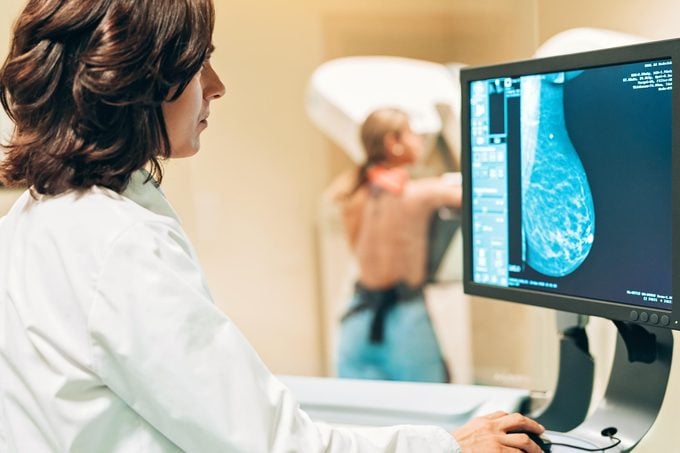New Study: Artificial Intelligence Detected Breast Cancer 20% Better Than Doctors
Updated: Aug. 03, 2023
Four women's health experts help uncover the benefits and risks at some institutions that are using AI to detect breast cancer.

Artificial intelligence is giving humans a run for the money in some ways that have many of us feeling uncertain. A possible upside of AI is that it’s showing effectiveness with helping to diagnose skin and lung cancers and certain heart conditions. Now, new research shows that AI readings of breast screening X-rays or mammograms may detect 20% more breast cancers than “standard” reads that were done by two radiologists—without increasing the rate of false-positive readings. What’s more, the study showed that the use of AI virtually halves the workload of already overworked breast radiologists.
The trial is ongoing, and the preliminary results were published in August 2023 in the peer-reviewed Lancet Oncology.
Of course, AI didn’t do it on its own, study author Kristina Lång, MD, PhD, tells The Healthy @Reader’s Digest: “Our study showed that when AI and radiologists work together the results are better.” Dr. Lång is an associate professor of Diagnostic Radiology at Skåne University Hospital in Malmö, Sweden. Mammogram images must still be obtained by radiologists.
For the study, half of about 80,000 Swedish women had their mammograms read by an AI program before it was examined by a radiologist. The other half had mammograms read by two radiologists without the use of AI. (This is the standard in Europe. The U.S. does not have the same standard but is also experiencing a shortage of breast radiologists.)
How does AI learn to spot breast cancer?
In a nutshell, AI learns from being fed large amounts of data that are then processed via an intuitive algorithm. “AI analyzes imaging features in the images that could indicate malignancy,” explains author Dr. Lång. AI can then flag scans that are more likely to show breast cancer.
Another potential benefit? “AI can also highlight suspicious findings on the mammogram which can help the radiologist to reduce overlooked findings,” she adds.
8 New Breast Cancer Treatments Some Oncologists Are Calling ‘Mind-Blowing’
The risks of AI-led breast cancer detection
The majority of women who undergo screening mammograms don’t have breast cancer. “AI-supported screening led to more detected cancers which were both invasive and in situ,” she says. In-situ breast cancers are considered non-invasive or even pre-invasive breast cancers.
“The detection of in situ breast cancer could also mean that overdiagnosis might increase when using AI,” she adds.
AI isn’t ready for its medical license just yet. “We need to study more in-depth on what type of cancers that are detected and also what cancers that we did not catch in screening,” she says.
AI always works best when it is paired with the human touch, says Dr. Nereo Segnan. Dr. Segnan is the chief of the unit of cancer epidemiology and director of the department of Screening at the Center for Epidemiology and Cancer Prevention in Turin, Italy. He co-authored an editorial accompanying the new study.
“Experienced breast radiologists are necessary to make the most of this new technology and are in shortage in most countries,” he tells The Healthy. “The benefits include savings and better efficacy, but risks may include overconfidence by non-experts. It has not been determined yet if AI can also learn to distinguish biological dangerous tumors from [low-risk] ones,” he says.
Mammography is our best tool for early breast cancer detection, but it’s not perfect, says Marisa C. Weiss, MD the chief medical officer and founder of Breastcancer.org in Ardmore, PA. Several factors, like dense breast tissue, limit a mammogram’s precision, including the accuracy and reliability of human interpretation of the images by a trained radiologist.
“AI is best used as a powerful tool—to supplement interpretation by a mammographer—to improve the chance that each woman will get the full benefit of early detection with a digital mammogram, with a lower risk of a (missed) delayed diagnosis,” she says. “It also helps with mammography deserts throughout the US and the world where there are shortages of trained and experienced radiologists available to read the mammograms.”
Still, AI is only as good as its teacher, she adds. “An AI model needs to be continuously trained and tested before and after they are deployed in the clinical setting—even for its use as a tool utilized by a mammographer to complement their interpretations of the study.”
Dr. Katherina Sawicki Calvillo, a breast surgeon and founder of New England Breast and Wellness in Wellesley, MA, says AI shows much promise in breast cancer screening. “Currently [some U.S.] breast imaging centers have two radiologists reading a screening mammogram for confirmation,” Dr. Calvillo says. “AI-supported screening could reduce the need by one radiologist and reallocate them to diagnostic imaging and workups like biopsies which could decrease waiting times for biopsies, which could lead to sooner diagnosis and time to treat could be positively affected.”
Many women are anxious about the results of screening mammograms, and the wait times only serve to increase this unease. “Normal mammogram findings could also be reported back sooner to nervous patients yielding a better patient experience,” she says. “More data needs to be obtained on how to incorporate what could be an important tool for cancer screening and diagnosis.”
- What Is ‘Medicaid Unwinding’? As Millions of Americans Are Disenrolled, Here’s How You Can Act
- Here’s Why Pee Smells the Way It Does, According to a Urology and Kidney Doctor
- What Is ‘Stress Poop’? Gastro Doctors Reveals the Science Behind This Extremely Normal Experience
- The 5 Health Benefits of Rollerblading You Probably Didn’t Know















